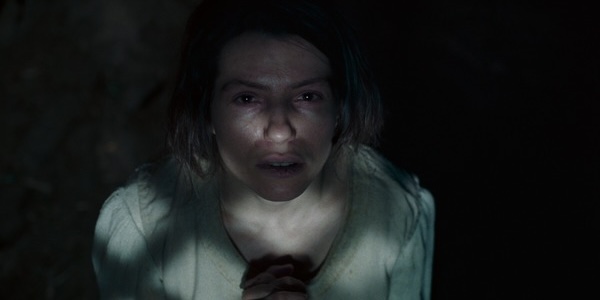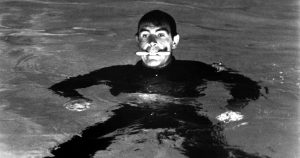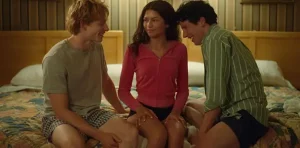
The Devil’s Bath, directed by Veronika Franz and Sevrine Fiala, is a feminist folk horror riff based on historical accounts of the lives of women in 18th century Austria. It begins with a striking cold-open in a faded field, where a baby cries unattended until a harried young woman only half-heartedly comforts it. By the time the woman has carried the baby off into the ominous-looking woods nearby, we can already sense that something isn’t quite right.
If this sounds like Robert Eggers‘ now-classic feminist folk horror story, The Witch, that’s because this film is very much like The Witch, from the cinematography (still, wide, eerie) to the score (silence interspersed with shrieking instrumental), to the narrative of repression, alienation, and abjection. It is also very much like Charlotte Colbert‘s She Will (2021), Małgorzata Szumowska‘s The Other Lamb (2019, not to be mistaken for Lamb, also comparable), and older folk horror films like Witchfinder General (1968).
All of this to say that, in 2024, the field of feminist folk horror is crowded enough that even Tribeca attendees have several films to choose from (Roxy Shih‘s Beacon and Elizabeth Sankey‘s documentary Witches both cover similar ground). For fans of this genre, though, The Devil’s Bath still has a lot to offer, drawing on thorough historical research to find a new angle on its material, backed up by compelling performances and some genuinely shocking moments.
“What Can I Do?”
Unlike many of the other films listed above, The Devil’s Bath is not about witchcraft. It’s about another form of “occult crime”: Suicide by proxy, the practice of committing murder in order to be executed (a death that allows for absolution, unlike suicide). For many mentally ill women in 18th century Europe, this grim Devil’s bargain became a last resort. The Devil’s Bath tells the story of Agnes (compellingly played by musician Anja Plaschg), a free-spirited newlywed who finds herself out of step with her husband’s stolid fishing community.
source: Tribeca Film Festival
In one poignant vignette, seemingly shot to resemble 18th century paintings, we see her struggling to keep up with a line of women picking rocks out of the ground; in another, her husband sweeps her butterfly collection into the fire. As her failures pile up, what begins as a search for acceptance becomes a grim and desperate slog for survival. At its heart, the film is a slow-burn portrait of mental illness, loneliness, and desperation in a world of rules, schedules, and codes of honor not everyone is able to fulfill.
In this sense, its closest analogue besides The Witch is not Midsommar as some have suggested (though flower crowns and A24-style triangular buildings indeed abound), but Roman Polanski‘s Repulsion (1965). Agnes, like Catherine Deneuve‘s Carol, is defined by a stifling passivity so complete and destructive, it becomes a tragic form of gendered social subversion. Both refuse to perform feminized labor like cooking and cleaning, letting the dishes pile up, rotting food and hanging flies a visual manifestation of their urgent discontent. Franz and Fiala‘s film is a study in antiquated process–– laundry in the river, fishing with nets, porridge over a fire–– and uses the physically difficult, emotionally numbing nature of these tasks to good advantage, bringing the viewer into the world of 18th century women’s work firmly enough to make Agnes’ fight with depression (what was then called “the Devil’s bath”) feel almost as bleakly relatable as Polanski‘s postmodern nightmare.
source: Tribeca Film Festival
Conclusion
What options do these women have? To commit suicide, according to Agnes’ priest, is to “say no to life,” but, for a woman whose passion for insect collecting outweighs her knowledge of husbandry, these circumstances are themselves a form of systemically imposed social death–– isolation from her family, a husband who ignores her, a mother-in-law who judges her every move, an unforgiving God. The combination leads to moments of startling violence, rendered with an aptly impersonal aura of brutality. “I’ve committed a crime,” the woman in the opening scene tells her priest; but, the film asks us, who truly bears the blame for these deaths, these women or the society who pushes them to the brink? Ultimately, though the package may feel familiar (at times too familiar), The Devil’s Bath still has cogent ideas to share.
Does content like this matter to you?
Become a Member and support film journalism. Unlock access to all of Film Inquiry`s great articles. Join a community of like-minded readers who are passionate about cinema – get access to our private members Network, give back to independent filmmakers, and more.





